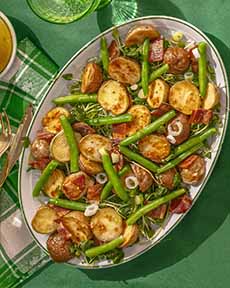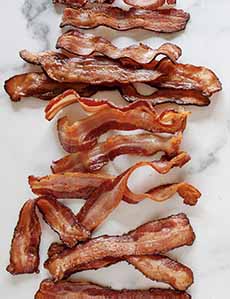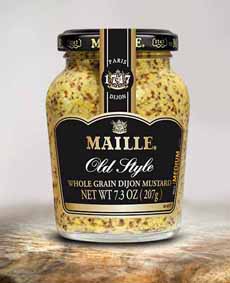Dijon Potato Salad Recipe With Bacon, Watercress & Green Beans
|
|
This potato salad recipe has enough green in it for St. Patrick’s Day—and it’s a wonderfully flavorful recipe. Created by Colavita, roasted baby potatoes combine with bacon, watercress, and green beans in a delicious Dijon mustard vinaigrette. Of course, it’s delicious year-round, served either warm (as indicated below) or chilled. > The history of watercress. 1. MAKE the dressing. In a small bowl, whisk the vinegar, Dijon mustard, and 1/4 teaspoon salt. Whisking constantly, slowly pour in the olive oil to form a thick dressing. Set aside. The dressing can be made ahead and stored in an airtight container in the fridge. 2. POSITION a rack in the center of the oven and heat the oven to 400°F. Line a baking sheet with parchment paper and place the strips of bacon on the parchment. 3. ROAST the bacon in the oven until it’s cooked and crispy, about 7 minutes. Remove from the oven and cool. Once cool, slice the bacon into ½” pieces. On another large rimmed baking sheet… 4. TOSS the potatoes with 1 tablespoon Colavita olive oil and 1/2 teaspoon salt. Roast, tossing occasionally, until golden brown and tender, about 20 minutes. Meanwhile… 5. BLANCH the green beans. Bring a medium pot of water to a boil. Add ½ teaspoon salt and the green beans. Boil for 4 minutes, drain. 6. POUR half of the dressing directly over the hot potatoes on the baking sheet. Toss until the potatoes absorb the dressing. Transfer the potatoes to a large salad bowl. 7. ADD the watercress, green beans, and bacon to the salad bowl and toss, adding 2 more tablespoons of the dressing if needed. 8. SEASON to taste with additional salt and pepper. Serve with the remaining dressing on the side. Watercress (Nasturtium officianale) is a salad green noted for its distinctive peppery, mustard-like flavor. It’s packed with vitamins and other nutrients, some of which are calcium, folic acid, iron, and vitamins A and C. The archaeological record of watercress can be found dating back 3,000 years to the Persians, Greeks, and Romans. It grew wild in cool flowing streams, where it grows submerged, floating on the water. It was subsequently cultivated. Watercress is a member of the Brassicaceae family of antioxidant-rich vegetables*. It is believed to have originated in or around ancient Greece, and remains an integral part of Mediterranean diets. While the ancients knew nothing about vitamins and minerals, the Persians did observe that their soldiers were healthier when watercress was part of their daily diet. The Persian King Xerxes (519 B.C.E.-466 B.C.E.) ordered his soldiers to eat watercress to keep them healthy during their long marches. It was also used by soldiers to both prevent and cure scurvy. A later general, Napoleon, Napoleon (1769-1821) was a huge watercress enthusiast [source]. Watercress has long been regarded medicinally. Among other uses, the Romans treated insanity with watercress and vinegar. Roman emperors ate watercress to help them make “bold decisions.” In Crete, islanders still swear by its aphrodisiac powers, and ancient watercress recipes are handed down from one generation to the next. The peppery salad green was also used as a breath freshener and palate cleanser. The Greeks also observed the health benefits of watercress. When Hippocrates, the father of medicine, founded the first hospital on the Island of Kos around 400 B.C.E., he is said to have located it hospital beside a stream so that he could grow a plentiful supply of watercress to help treat his patients [source]. One important use was to treat blood disorders. Later, the herbalist John Gerard (1542-1612) promoted watercress as a remedy for scurvy [source]. One of Britain’s best-known dishes, watercress soup, became very popular in the 17th century when it was claimed that it cleansed the blood. Across the pond, watercress was recorded as a menu item at the very first Thanksgiving celebration, in 1621. Lewis and Clark regularly found watercress on their trek across the Louisiana Purchase in 1804-1806. The U.S. Army planted watercress in the gardens of forts along the western trails, as food for their soldiers. In the 1994 book, James Cook and the Conquest of Scurvy, author Francis E. Cuppage notes that Captain James Cook was able to circumnavigate the globe three times (between 1768 and 1779), due in part to his use of watercress in the diet of his sailors. The first notation of watercress cultivated on the Continent is by Nicholas Messier in Erfurt, Germany, in the mid-16th century. Cultivation began in England in 1808s, when a farmer near London popularize it as a salad ingredient. Typical of food trends, it was not long before it became increasingly difficult to meet the sudden increase in demand for watercress [source]. Eating a bag of watercress is said to be a good cure for a hangover. We don’t know anyone who’s tried it, but a peppery watercress salad would be refreshing after a long night. ________________ *The high-antioxidant Brassicaceae (brah-si-KAY-see-ay) family of flowering plants—formerly the Cruciferae) and sometimes called the Brassicas or cruciferous vegetables for short—are nutritional powerhouses, packed with potent, cancer-fighting phytonutrients. Members include arugula, bok choy, broccoli, Brussels sprouts, cabbage, cauliflower, collards, horseradish/wasabi, kale, kohlrabi, mizuna, mustard greens, radish, rapeseed/canola, rapini, rutabaga, tatsoi, turnips, and watercress, among others. Watercress is often referred to as a member of the “mustard family.” The Brassicaceae family is commonly known as the mustards, the crucifers, or the cabbage family. |
|









